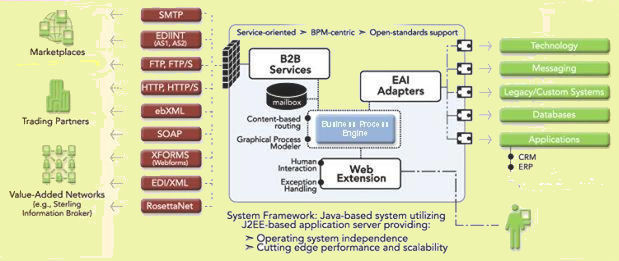Architectural Overview
Sterling B2B Integrator's architecture is built on a multi-level platform, which enables efficient development of new features. You can respond rapidly to business and technology changes with this design.
- Supports a business process management approach to integration
- Provides enterprise scalability, manageability, and security
- Delivers non-invasive integration with pre-existing systems
- Supports emerging e-business standards frameworks
- Enables rapid change management and deployment
- Enables multiple interaction styles
- Offers a diverse, open-ended functionality set that you can extend in numerous ways
- Facilitates interoperability of integrating software
- Promotes widespread adoption of key industry standards
- Enables data transformation and data management activities that are the cornerstone of your processes
The following figure illustrates Sterling B2B Integrator's architecture.

The figure depicts a Sterling B2B Integrator system using many B2B services and EAI adapters. Your configuration will use only the services and adapters that are required for integration activities. The figure also shows a mail box component and integrated human interaction points through Web Extensions, which you may or may not decide to employ.
The following steps explain the progress of a sample process moving through this architecture:
A trading partner sends a document such as a purchase order through a B2B transport protocol (SMTP, EDIINT, FTP, or HTTP) to your organization, using the appropriate service.
The arrival of the document triggers the business process you have configured for the document, and possibly, for this specific trading partner. The Business Process Engine manages the progression of steps in the business process.
The business process de-envelopes the document to obtain instructional information such as routing directions, in addition to the body content of the document.
- Based on the data in the document, the business process progresses to the next step. This might include passing the document (through EAI adapters) into one or more internal applications such as:
- A PeopleSoft™ order management system
- A Web Extensions application (online form) for human interaction with the data, such as a manager's review and approval prior to routing to the next step
- An accounting system for credit verification, and then on to an order management system
- A mailbox application to store the data until a scheduled time when the business process progresses to the next activity
The process may end here or it may include additional steps, such as adapter-assisted interaction with one or more enterprise systems, to generate a response document to be returned to the trading partner, again using B2B transport services.
- For technical information about system design, see Sterling B2B Integrator Technical Framework
For information about the functions supported by the architecture, see Sterling B2B Integrator's Functional Framework
- For information about the Business Process Engine, see Business Process Engine
For details about the core components of Sterling B2B Integrator, including B2B services, EAI adapters, and Web Extensions, see Fundamental Components of Sterling B2B Integrator